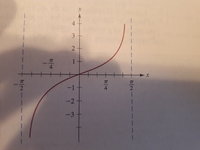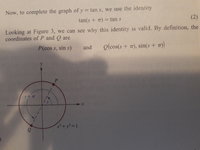harpazo
Full Member
- Joined
- Jan 31, 2013
- Messages
- 891
Cohen stated:
"First, the identity tan(-x) = - tan x tells us that the graph of y = tan x is symmetric about the origin. So, after reflecting the graph about the origin, we can draw the graph of y = tan x on the interval (-pi/2, pi/2) as shown in the figure."
Am I right for saying that y = tan x has an asymptote at -pi/2 and pi/2?
I do no understand what Cohen means by introducing tan(-x) = - tan x.

He then goes on to say the following which makes no sense to me. In this picture, Cohen introduces the unit circle. I do not see the connection between the unit circle and the tangent function as used here.

I think it is easier for me just to watch video clips on You Tube showing how to graph the trig functions. At the same time, I would like to understand my textbooks. Otherwise, it makes no sense to have math textbooks in my small library of books.
"First, the identity tan(-x) = - tan x tells us that the graph of y = tan x is symmetric about the origin. So, after reflecting the graph about the origin, we can draw the graph of y = tan x on the interval (-pi/2, pi/2) as shown in the figure."
Am I right for saying that y = tan x has an asymptote at -pi/2 and pi/2?
I do no understand what Cohen means by introducing tan(-x) = - tan x.

He then goes on to say the following which makes no sense to me. In this picture, Cohen introduces the unit circle. I do not see the connection between the unit circle and the tangent function as used here.

I think it is easier for me just to watch video clips on You Tube showing how to graph the trig functions. At the same time, I would like to understand my textbooks. Otherwise, it makes no sense to have math textbooks in my small library of books.
